人教版人教版小学英语五年级上册英文教案全集
- 格式:docx
- 大小:246.36 KB
- 文档页数:141
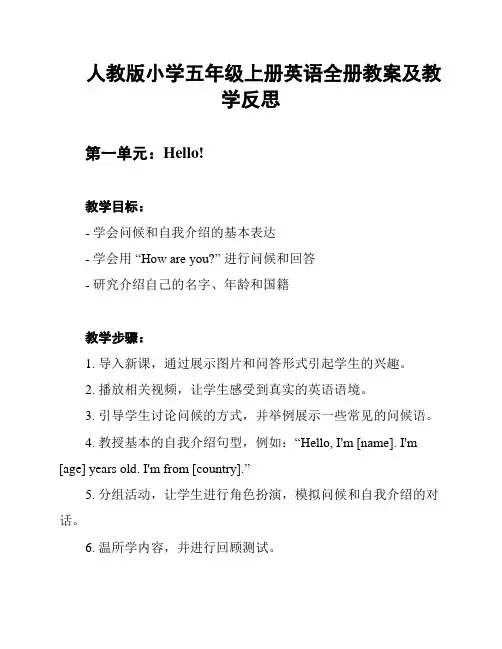
人教版小学五年级上册英语全册教案及教
学反思
第一单元:Hello!
教学目标:
- 学会问候和自我介绍的基本表达
- 学会用“How are you?” 进行问候和回答
- 研究介绍自己的名字、年龄和国籍
教学步骤:
1. 导入新课,通过展示图片和问答形式引起学生的兴趣。
2. 播放相关视频,让学生感受到真实的英语语境。
3. 引导学生讨论问候的方式,并举例展示一些常见的问候语。
4. 教授基本的自我介绍句型,例如:“Hello, I'm [name]. I'm [age] years old. I'm from [country].”
5. 分组活动,让学生进行角色扮演,模拟问候和自我介绍的对话。
6. 温所学内容,并进行回顾测试。
教学反思:
本节课以问候和自我介绍为主题,通过生动的教学活动有效吸
引了学生的注意力。
学生们积极参与了讨论和角色扮演,提高了他
们的口语表达能力和互动能力。
教师在教学过程中注重培养学生的
兴趣,采用多媒体资源和活动形式,促进了学生的参与和学习效果。
通过回顾测试,发现大部分学生能够正确运用所学知识进行问候和
自我介绍。
然而,仍有部分学生在发音和语法上存在一些困难,需
要进一步巩固。
教师将关注这些学生,提供额外的练习和指导,以
促进他们的语言能力发展。
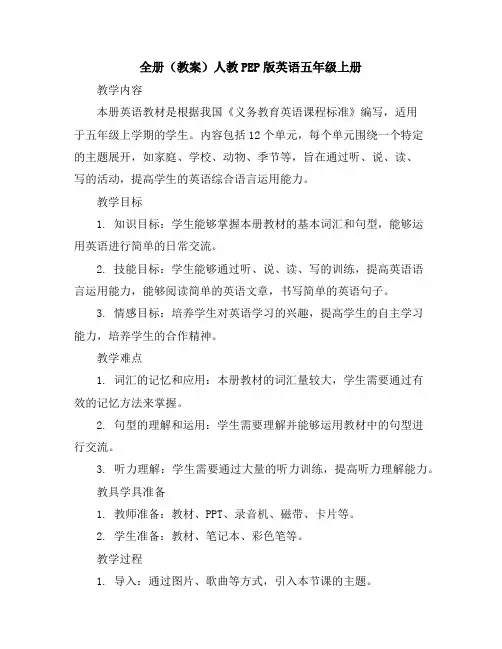
全册(教案)人教PEP版英语五年级上册教学内容本册英语教材是根据我国《义务教育英语课程标准》编写,适用于五年级上学期的学生。
内容包括12个单元,每个单元围绕一个特定的主题展开,如家庭、学校、动物、季节等,旨在通过听、说、读、写的活动,提高学生的英语综合语言运用能力。
教学目标1. 知识目标:学生能够掌握本册教材的基本词汇和句型,能够运用英语进行简单的日常交流。
2. 技能目标:学生能够通过听、说、读、写的训练,提高英语语言运用能力,能够阅读简单的英语文章,书写简单的英语句子。
3. 情感目标:培养学生对英语学习的兴趣,提高学生的自主学习能力,培养学生的合作精神。
教学难点1. 词汇的记忆和应用:本册教材的词汇量较大,学生需要通过有效的记忆方法来掌握。
2. 句型的理解和运用:学生需要理解并能够运用教材中的句型进行交流。
3. 听力理解:学生需要通过大量的听力训练,提高听力理解能力。
教具学具准备1. 教师准备:教材、PPT、录音机、磁带、卡片等。
2. 学生准备:教材、笔记本、彩色笔等。
教学过程1. 导入:通过图片、歌曲等方式,引入本节课的主题。
2. 新课内容展示:通过PPT、卡片等方式,展示本节课的主要词汇和句型。
3. 练习:通过听、说、读、写的活动,让学生练习本节课的内容。
板书设计1. 主题:明确本节课的主题,使学生能够明确学习目标。
2. 主要词汇和句型:通过板书,展示本节课的主要词汇和句型,方便学生记忆和运用。
3. 练习:通过板书,展示本节课的练习内容,引导学生进行有效的练习。
作业设计1. 听力练习:通过听录音,完成相关的练习。
2. 口语练习:通过模仿录音,进行口语练习。
3. 阅读练习:通过阅读教材,完成相关的练习。
4. 写作练习:通过书写句子,进行写作练习。
课后反思1. 教师需要根据学生的反馈,及时调整教学方法,提高教学效果。
2. 学生需要通过课后作业,巩固课堂所学知识,提高学习效果。
3. 教师需要定期检查学生的学习情况,及时发现问题并解决。
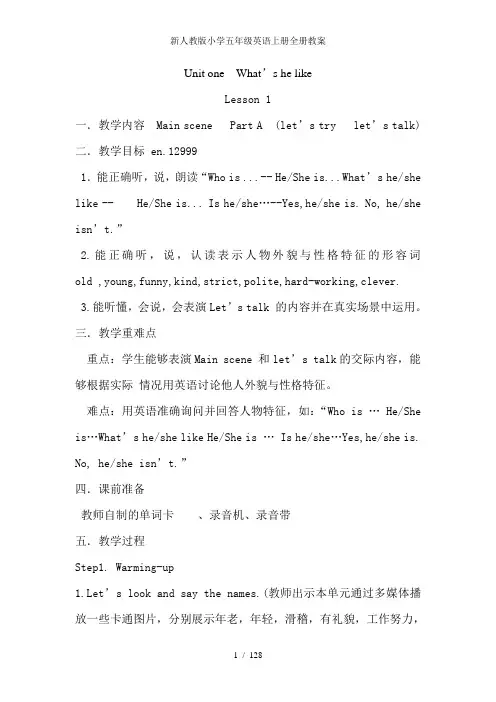
Unit one What’s he likeLesson 1一.教学内容 Main scene Part A (let’s try let’s talk)二.教学目标 en.129991.能正确听,说,朗读“Who is ...-- He/She is...What’s he/she like -- He/She is... Is he/she…--Yes,he/she is. No, he/she isn’t.”2.能正确听,说,认读表示人物外貌与性格特征的形容词old ,young,funny,kind,strict,polite,hard-working,clever.3.能听懂,会说,会表演Let’s talk 的内容并在真实场景中运用。
三.教学重难点重点:学生能够表演Main scene 和let’s talk的交际内容,能够根据实际情况用英语讨论他人外貌与性格特征。
难点:用英语准确询问并回答人物特征,如:“Who is … He/She is…What’s he/she like He/She is … Is he/she…Yes,he/she is. No, he/she isn’t.”四.课前准备教师自制的单词卡、录音机、录音带五.教学过程Step1. Warming-up1.Let’s look and say the names.(教师出示本单元通过多媒体播放一些卡通图片,分别展示年老,年轻,滑稽,有礼貌,工作努力,聪明,严格等外貌与性格特征,让学生认读,说一说这是谁,怎么样。
)2.Let’s listen and sing”Who’s your teacher”Step2. Presentationen.129991.学习Main scene(1)出示Main scene中的部分教学挂图,让学生观察。
(2)看图回答问题。
Dialogue1: Who can you see in the picture(Wu Yifan,Amy,Oliver and a teacher.)Dialogue2: What are they talking about(The teacher introduces classmates to each other.)Dialogue2:Who is a new student(Oliver)(3)听录音,模仿朗读,理解对话内容。

人教版小学英语五年级上册全册教案目录Unit 1 Classmates《Lesson 1》 (3)Unit 1 Classmates《Lesson 2》 (7)Unit 1 Classmates《Lesson 3》 (12)Unit 1 Classmates《Let’s Spell》 (15)Unit 1 Classmates《Let’s Check》 (18)Unit 1 Classmates《Story Time》 (25)Unit 2 Teachers《Lesson 1》 (30)Unit 2 Teachers《Lesson 2》 (36)Unit 2 Teachers《Lesson 3》 (40)Unit 2 Teachers《Let’s Check》 (44)Unit 3 Animals《Lesson 1》 (47)Unit 3 Animals《Lesson 2》 (51)Unit 3 Animals《Lesson 3》 (58)Unit 3 Animals《Fun Time》 (64)Unit 4 Shopping Day《Lesson 1》 (69)Unit 4 Shopping Day《Lesson 2》 (74)Unit 4 Shopping Day《Fun Time》 (77)Unit 5 TV Shows《Lesson 1》 (83)Unit 5 TV Shows《Lesson 2》 (85)Unit 6 Chores《Lesson 1》 (89)Unit 6 Chores《Lesson 2》 (94)Unit 6 Chores《Lesson 3》 (99)Unit 6 Chores《Fun Time》 (106)Unit 6 Chores《Story Time》 (112)Unit 1 Classmates《Lesson 1》1教学目标知识与能力目标能熟练掌握单词for different bench then能初步运用句型there wasn’t there weren’t there is there are描述事物或场景的变化。
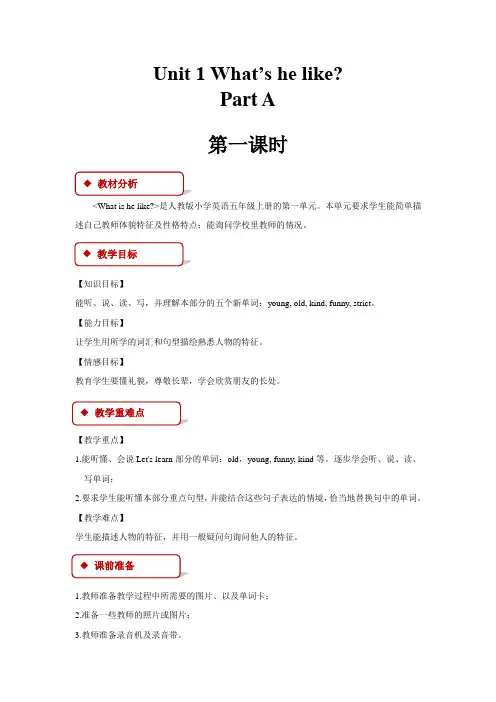
Unit 1 What’s he like?Part A第一课时<What is he like?>是人教版小学英语五年级上册的第一单元。
本单元要求学生能简单描述自己教师体貌特征及性格特点;能询问学校里教师的情况。
【知识目标】能听、说、读、写,并理解本部分的五个新单词:young, old, kind, funny, strict。
【能力目标】让学生用所学的词汇和句型描绘熟悉人物的特征。
【情感目标】教育学生要懂礼貌,尊敬长辈,学会欣赏朋友的长处。
【教学重点】1.能听懂、会说Let's learn部分的单词:old,young, funny, kind等。
逐步学会听、说、读、写单词;2.要求学生能听懂本部分重点句型,并能结合这些句子表达的情境,恰当地替换句中的单词。
【教学难点】学生能描述人物的特征,并用一般疑问句询问他人的特征。
1.教师准备教学过程中所需要的图片、以及单词卡;2.准备一些教师的照片或图片;3.教师准备录音机及录音带。
Step 1. Warm-up1.Free talk2.简单介绍各科老师。
T: Now let me ask and you answer. (出示英语书) What’s this?Ss: It’s an English book.T: And I teach you English. So I am your…Ss: English teacher.然后教师出示其他科目老师的照片和相应的课本,和学生进行类似的对话。
Step 2. Preview师生根据实际就各科老师的体貌特征进行问答练习,如:T: Who’s your music teacher?Ss: ……T: Is he / she thin / fat / tall / short / …?Ss: Yes, he / she is. (No, he / she isn’t.)T: Now read after me. Thin, thin (Fat, fat / Tall, tall / Short, short). My music teacher is thin (fat / tall / short).Ss: Thin, thin (Fat, fat / Tall, tall / Short, short). My music teacher is thin (fat / tall / short).Step 3. Presentation1. A. Let’s learn(1) 教学新单词①教学单词“old”和“young”②教学单词“kind”和“funny”③教学单词“strict”教师出示平时比较严厉的一位任课老师的照片,与学生进行对话,如:T: Look at the picture. Who’s he / she?Ss: He’s / She’s …T: Is he / she kind?Ss: No, he / she isn’t.T: You’re right. He’s / She’s not kind. He’s /She’s very strict. Read after me, please. He’s /She’s strict.Ss: He’s / She’s strict.④教师把本节课学习的五个新单词写在黑板上,并带读。
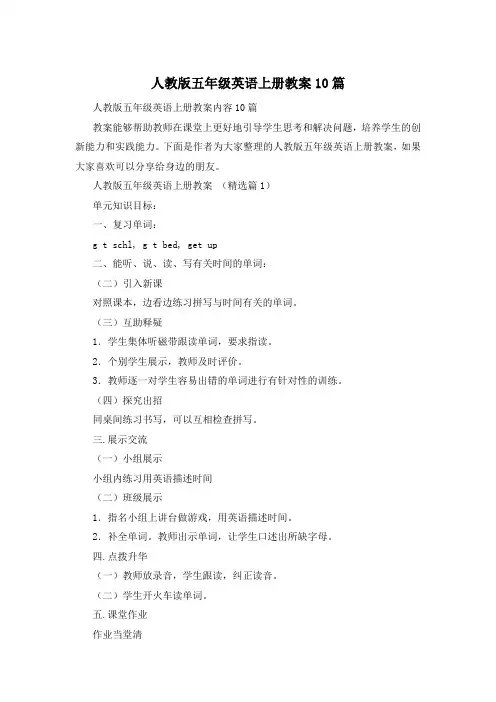
人教版五年级英语上册教案10篇人教版五年级英语上册教案内容10篇教案能够帮助教师在课堂上更好地引导学生思考和解决问题,培养学生的创新能力和实践能力。
下面是作者为大家整理的人教版五年级英语上册教案,如果大家喜欢可以分享给身边的朋友。
人教版五年级英语上册教案(精选篇1)单元知识目标:一、复习单词:g t schl, g t bed, get up二、能听、说、读、写有关时间的单词:(二)引入新课对照课本,边看边练习拼写与时间有关的单词。
(三)互助释疑1.学生集体听磁带跟读单词,要求指读。
2.个别学生展示,教师及时评价。
3.教师逐一对学生容易出错的单词进行有针对性的训练。
(四)探究出招同桌间练习书写,可以互相检查拼写。
三.展示交流(一)小组展示小组内练习用英语描述时间(二)班级展示1.指名小组上讲台做游戏,用英语描述时间。
2.补全单词。
教师出示单词,让学生口述出所缺字母。
四.点拨升华(一)教师放录音,学生跟读,纠正读音。
(二)学生开火车读单词。
五.课堂作业作业当堂清1.单词拼写人教版五年级英语上册教案(精选篇2)一、学情分析这学期担任五(1)教学任务,五(1)共有学生人数56人,多数学生基础不够好,学习很吃力,学习积极性不高,有的因此扰乱课堂次序,这给教学带来不少困难。
大部分学生上课表现还是很不错的。
总的来说,课堂上,老师容易掌控学生的学习进度。
二、教材分析五年级下册学生用书Let’s learn部分的词汇仍然是围绕话题归类出现的。
这样有利于学生记忆和开展话题的讨论。
与五年级上册相同,本册Let’s learn 中的大部分词汇要求学生做到听、说、读、写四会掌握(即加粗的单词)。
用来巩固复习词汇的活动主要是结对和小组活动,以及Let’s find out等启发学生主动思考的活动。
五年级下册学生用书的Let’s try也是一项brainstorm式的活动,这一点与五年级上册相同。
另外,在这一部分基本上都安排了一个任务型活动,需要学生通过问答、思考或讨论来完成。
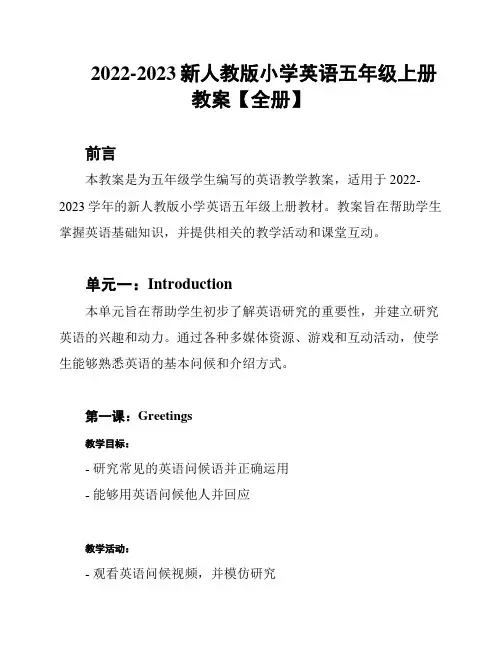
2022-2023新人教版小学英语五年级上册教案【全册】前言本教案是为五年级学生编写的英语教学教案,适用于2022-2023学年的新人教版小学英语五年级上册教材。
教案旨在帮助学生掌握英语基础知识,并提供相关的教学活动和课堂互动。
单元一:Introduction本单元旨在帮助学生初步了解英语研究的重要性,并建立研究英语的兴趣和动力。
通过各种多媒体资源、游戏和互动活动,使学生能够熟悉英语的基本问候和介绍方式。
第一课:Greetings教学目标:- 研究常见的英语问候语并正确运用- 能够用英语问候他人并回应教学活动:- 观看英语问候视频,并模仿研究- 听录音并跟读常见的英语问候语- 小组互动练,用英语互相问候第二课:Self-Introduction教学目标:- 研究用英语自我介绍并描述个人基本信息- 能够与他人交流自己的姓名、年龄、爱好等内容教学活动:- 观看自我介绍视频,并模仿研究表达- 练自我介绍,鼓励学生互相交流信息- 制作自我介绍海报,展示给全班同学单元二:Daily Routines本单元旨在帮助学生研究和描述日常生活中的常见活动,如起床、吃早饭、上学等。
通过角色扮演、游戏和绘画等活动,使学生能够在日常交流中运用英语。
第三课:Morning Routine教学目标:- 研究用英语描述每天早上的常见活动- 能够用英语表达自己的早晨惯教学活动:- 观看相关活动的图片,并用英语描述- 角色扮演,模拟每天早上的活动过程- 小组合作,讨论并展示自己的早晨惯第四课:Daily Activities教学目标:- 研究用英语描述日常活动的时间和顺序- 能够用英语描述自己的日常活动教学活动:- 听录音并跟读日常活动的时间和顺序- 制作日程表,描述每天的日常活动- 分组竞赛,用英语描述日常活动的时间和顺序单元三:Family本单元旨在帮助学生研究和描述家庭成员,包括父母、兄弟姐妹等。
通过问答、游戏和绘画等活动,使学生更好地理解家庭成员之间的称呼和关系。
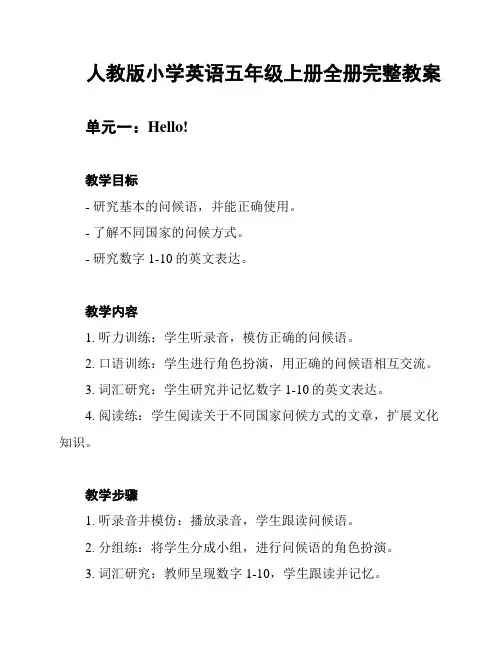
人教版小学英语五年级上册全册完整教案单元一:Hello!教学目标- 研究基本的问候语,并能正确使用。
- 了解不同国家的问候方式。
- 研究数字1-10的英文表达。
教学内容1. 听力训练:学生听录音,模仿正确的问候语。
2. 口语训练:学生进行角色扮演,用正确的问候语相互交流。
3. 词汇研究:学生研究并记忆数字1-10的英文表达。
4. 阅读练:学生阅读关于不同国家问候方式的文章,扩展文化知识。
教学步骤1. 听录音并模仿:播放录音,学生跟读问候语。
2. 分组练:将学生分成小组,进行问候语的角色扮演。
3. 词汇研究:教师呈现数字1-10,学生跟读并记忆。
4. 阅读练:学生阅读课本中关于不同国家问候方式的文章,并回答相关问题。
5. 小结回顾:检查学生对数字1-10的掌握情况,并复问候语的正确使用。
课堂作业1. 记忆数字1-10的英文表达。
2. 回家后用英文问候家人和朋友。
3. 阅读课本中的文章,并思考自己国家的问候方式。
教学评价1. 面对学生角色扮演时的表现,评价其是否能正确使用问候语。
2. 通过课堂讨论和阅读练,评价学生对不同国家问候方式的了解。
3. 检查学生记忆数字1-10的能力。
教学资源- 电子设备:播放录音、展示课件。
- 教材:《人教版小学英语五年级上册》。
总结本节课主要教授了基本的问候语和数字1-10的英文表达,通过听说读的综合训练,让学生能够灵活运用。
同时,通过阅读融入文化知识,拓展学生的视野。
通过本节课的学习,学生将能够准确地使用问候语,增加对不同国家文化的理解。
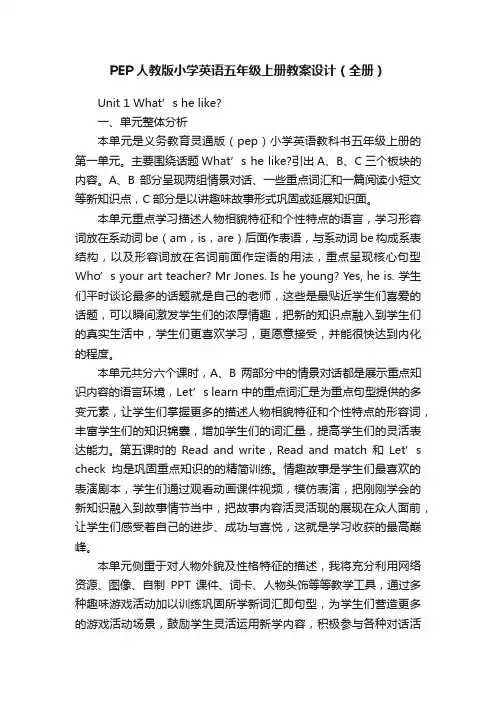
PEP人教版小学英语五年级上册教案设计(全册)Unit 1 What’s he like?一、单元整体分析本单元是义务教育灵通版(pep)小学英语教科书五年级上册的第一单元。
主要围绕话题What’s he like?引出A、B、C三个板块的内容。
A、B部分呈现两组情景对话、一些重点词汇和一篇阅读小短文等新知识点,C部分是以讲趣味故事形式巩固或延展知识面。
本单元重点学习描述人物相貌特征和个性特点的语言,学习形容词放在系动词be(am,is,are)后面作表语,与系动词be构成系表结构,以及形容词放在名词前面作定语的用法,重点呈现核心句型Who’s your art teacher? Mr Jones. Is he young? Yes, he is. 学生们平时谈论最多的话题就是自己的老师,这些是最贴近学生们喜爱的话题,可以瞬间激发学生们的浓厚情趣,把新的知识点融入到学生们的真实生活中,学生们更喜欢学习,更愿意接受,并能很快达到内化的程度。
本单元共分六个课时,A、B两部分中的情景对话都是展示重点知识内容的语言环境,Let’s learn 中的重点词汇是为重点句型提供的多变元素,让学生们掌握更多的描述人物相貌特征和个性特点的形容词,丰富学生们的知识锦囊,增加学生们的词汇量,提高学生们的灵活表达能力。
第五课时的Read and write,Read and match和Let’s check均是巩固重点知识的的精简训练。
情趣故事是学生们最喜欢的表演剧本,学生们通过观看动画课件视频,模仿表演,把刚刚学会的新知识融入到故事情节当中,把故事内容活灵活现的展现在众人面前,让学生们感受着自己的进步、成功与喜悦,这就是学习收获的最高巅峰。
本单元侧重于对人物外貌及性格特征的描述,我将充分利用网络资源、图像、自制PPT课件、词卡、人物头饰等等教学工具,通过多种趣味游戏活动加以训练巩固所学新词汇即句型,为学生们营造更多的游戏活动场景,鼓励学生灵活运用新学内容,积极参与各种对话活动,热情交流,整理并汇集成信息报告,并且激励学生们积极参与报告演讲,展现自己在本单元的欣喜收获。
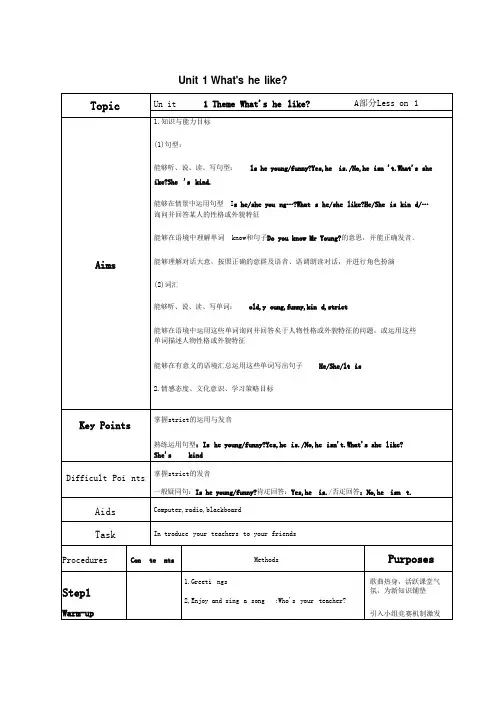
Unit 1 What's he like?Step2Prese ntatio n Let's talk&learn3,Groups Division4,Introduce Oliver,then Let 's try.1,教师呈现教材中和现实中教师的图片。
Who sthis boy/girl? 操练Do you know…?No,ldon't.Who's he/she?He/She is Miss/Ms/Mr.…a/your/new …teacher.学习兴趣Let's try 为Let'stalk 做铺垫Old new 对比2,指着图片继续问: Is he you ng?操练you ng.紧接着下一张图片,图片显示教师是old.两者进行对比,操练。
3,教师呈现人物图片提问:Is he/she young/old?学生回答:Yes,he/she is.No,he/she isn 't.最后呈现MrYoung,问:Do you know Mr You ng?弓l 导学生提问Ishe…?总结他的外貌或性格特征。
引出He is funny,too.教学funny,通过拆音方式教学并提醒单词中有两个n=4,教师呈现书中各种教师表情,进行句型的操练。
5,教师问:What kind of teachers do you like?学生回答:I like funny/young teachers.6,教师问:What kind of teachers does he like?听录音,选择通过各种方式操练单词7,教师问:Does Oliver know Mr Young?ls Mr Youngan En glish teacher? 听录音,回答。
8,listen and imitate9,We know Mr Young is a music teacher?Who is ZhangPeng's scienee teacher?Miss Green.Is she…?引出kind。

5篇人教版pep五年级上册英语教案5篇人教版pep五年级上册英语教案认真备课,不但备学生而且备教材备教法,根据教材内容及学生的实际,设计课的类型,拟定采用的教学方法,并对教学过程的程序及时间安排都作了详细的记录,认真写好教案。
以下是带来的人教版pep五年级上册英语教案内容,感谢您的阅读,希望能帮助到您!人教版pep五年级上册英语教案1教材分析:1、本模块学习用how many和how much问数量多少,并会表演在商场购物的简单会话。
2、学生对可数名词和不可数名词认识可能有困难,应详细讲清。
学情分析:1、农村小学英语基础差,学生程度不齐,部分学生发音不准。
2、学生对购物比较熟悉,会话取材简单,便于练习。
3、对部分差生需要耐心辅导,帮助他们度过单词关、语音关。
教学目标:1、学习句型How many bananas do you want?How much cheese do you want?Do you like cheese,Lingling?No, I don,t ,I like cheese.2、使用how many, how much询问多少。
3、教育学生在家帮助父母购买物品、做点力所能及的家务活。
教学重点:1、说出购物的过程,表演课本对话。
2、使用how many , how much问多少。
3、分清可数名词和不可数名词。
教学过程:一、热身复习学生跟录音机唱Module1中学习的英语歌曲。
二、课文导入问一个学生的.书包是在哪里买的,多少钱,引出单词shop how much yuan need等。
三、课文教学A、学习单词,学生反复跟读后,教师拿出单词卡片,让学生看着汉语说英语,然后看着英语说汉语,检查单词记忆情况及读音是否正确。
B、SB活动1先听录音,然后解释句子意思,并解释how many ,how much的用法及区别,提出可数名词和不可数名词,并详细解释让学生分清楚。
C、小组练习听几遍录音后,分小组分角色练习对话,教师在课堂上流动辅导,并让优秀学生带动差生练习。
人教版五年级英语上册全册教案范文模板5篇教案可以恰当地选择和运用教学方法,调动学生学习的积极性,面向大多数学生,同时注意培养优秀生和提高后进生,使全体学生都得到发展。
以下是带来的人教版五年级英语上册全册教案内容,感谢您的阅读,希望能帮助到您!人教版五年级英语上册全册教案1Im in New York nowTeaching objectives:1. Words: arrive taxi flat building made again2. Sentences:Grandma made Chinese food for me.I want to try American food.I will write again soon.3. Practise to pronounce ‘wh’‘wr’.4. Learn the song: It’s a big exciting world.Teaching properties: cards tape-recorder picturesTeaching proceduresWarmer:1. Stick the pictures of unit 1 on the board. Have the students come to thefront and mime the text of unit 1.2. Say a sentence in the present tense and get thestudents say it in thepast tense.Examples:T: Daming goes to New York.Ss: Daming went to New York.T: Grandma meets Daming.Ss: Gradma met Daming.Teach the text:1. Raise the picture of the Statue of Liberty and ask: What is it ? Whereis it?”Guide the students say: It’s the statue of Liberty. It’s in New York”.T: Daming is in New York now. Let’s see who met him at the airport. What hesaw in New York and What food he wanted to eat.2. Play the tape. Have the students listen and underline the new words inbooks.3. Teach the new words.4. Play the tape again. Have the students listen and say. After this, getthe students to answer the following questions:⑴Who met Daming at the airport? (Grandma and Simon)⑵What did Daming see in New York? (Buildings, cards and people)⑶What food did he want to try? (American food)5. Complete activity 2 in SB. (Get the students to ask and answer inpairs)6. Practise to pronounce wh wr.7. Learn the song: It’s a big exciting world.8. Complete exercise 1 in AB.Homework:Practise the following sentences in pairs:Where are you from?Where are you going to go?Where are you going to go there?Where are you going to do there?Designs:Module 10 Unit 2 I’m in New York nowArrive Grandma mad Chinese food for me.TaxiFlat I want to try American food.buildingmade I will write again soon人教版五年级英语上册全册教案2where are you going to go教学目标:1、能够识别单词:list airport shoe ticket toothbrush.2、学习目标语句:Where are you going to go? What are you going to take? When areyou going to go? Who’s going to go with you?3、功能:能够谈论旅行前的准备和具体事宜。
新人教版五年级英语上册教案5篇新人教版五年级英语上册教案篇1一、教学目标与要求1. 知识与能力目标(1)能够听说读写单词blind。
能够听说认读单词special(2)能够听说读写句子 This dog can help him.Can Fifi help the blind people? No, he can’tHe only wants to play.2. 情感态度目标教育学生要关心残疾人,帮助残疾人。
二、教学重点及难点掌握用can 表述能力的陈述句和一般疑问句的问答,并能在真实情景中运用。
三、课前准备多媒体课件、单词卡片、图片四、教学过程Step 1 Warm up1. 师生问好。
2. 自由谈话。
T: What can you do ?Ss: I can…T: Can you …?Ss: Yes, I can. / No, I can’t.Step 2 Presentation and practice1. T: I can draw pictures. 教师在黑板上画一只小狗。
What can the dog do?/ What can’t the dog do?Ss: This dog can…This dog can’t…老师将这两个句型结构写在黑板上。
2. 老师出示一张电视机的图片,电视机里正在播放导盲犬帮助盲人的画面。
T: What can you see on the TV?Ss: I can see a man and a dog.T: Look at the man. He is special. He can’t see. He is blind.This dog can help him. It’s a special dog.学习单词 blind, special3. 学习课文第二段。
(1)出示一个电视节目主持人的图片。
T: This TV presenter is talking about them. Listen carefully and answer questions: Are they in China? Who can help the blind people?播放课文第二段的录音,学生听录音回答问题。
Unit1 What does she look like?Period 1总第1个教案一、教学目标1、能听懂、会说新单词tall, short,young,old, round ,long.2、能掌握What does she look like? She’s tall and has long hair等描述外貌的句型3、能正确运用What does she look like? She’s…描述人物外貌特征。
二、教学重点及难点重点:掌握四会单词tall, short,young,old, round ,long.句型What does she look like? She’s…难点:用What does she look like? She’s…结构描述人物的外貌特征。
三、教学准备单词卡片和图片、画画工具、教学挂图、教学磁带等。
2、教学步骤Step 1 Warming up1、师生问候。
2、复习人体各部位的单词(1)在黑板上画一个人脸,边画边问:What’s this? It’s a nose/eye/hair/an ear.This is a face. A round face.(2)运用句型:touch your…nose,eye,ear ,head,hair,hand,leg, foot,face.朗读2遍,翻译一遍。
Ear ,ear, touch your ear…ect.Step 2 Presentation and drill1、引入新知。
把我们班新来的一名同学悄悄叫出去不让大家看见,然后问大家:we have a new student this year. What’s her name?What does she look like?先用中文猜猜新同学的长相高矮,头发短长,眼睛鼻子的大小,脸型等。
然后边谈论边板书新单词tall, short,young,old, round ,long.板书完以后,让学生自学单词:理解词义,猜猜读音。
5篇人教版pep小学英语五年级上册教案人教版pep小学英语五年级上册教案1Unit 3 What’s Your Favourite Food ?单元教学目标:1、能力目标(1) 能够提问并回答三餐所吃的食物,如:What do you have for lunch today/on Mondays……?We have tomatoes, tofu and fish……(2) 能够简单描述一些食物的味道,如:The apples are sweet……(3) 能够提问并回答最喜欢吃的食物是什么,并说出原因,如:What’s your favourite food? I like apples. They are sweet……(4) 能够听懂、会唱歌曲“What do you have for lunch?”和本单元的歌谣。
2、知识目标(1) 认读A、B部分Let’s learn Let’s talk 中的单词和句子,并掌握四会单词。
(2) 掌握四会句子,读懂对话内容,完成句子填空。
(3) 了解Let’s start Group/pair work Task time等部分的内容。
(4) 了解Pronunciation中的字母组合ow, oa, fr, fl的发音规则,认读相关的单词。
(5) 了解Story time Good to know等部分的内容。
3、情感、策略、文化等有关目标(1) 培养学生的合作精神和创新意识,引导学生通过以旧带新的方式自主学习,同时也要注重合作学习。
(2) 了解中国表示美好愿望的传统美食,并介绍其他国家的代表性食物,开拓学生的视野。
单元教学课时安排:第一课时:Let’s start Main scene Let’s chant A Let’s l earn Group work第二课时:A let’s try Let’s talk Talk and match C Good to know第三课时:A Read and write Group work C Let’s sing第四课时:B Let’s try Let’s talk Pair work C Story time第五课时:B Let’s try Let’s talk Pair work C Task time第六课时:B Read and write Group work C Pronunciation Let’s check第一课时一、教学目标与要求:1、能够听、说、读、写本课时四会单词: tomato, tofu, greenbeans,fish, potato, eggplant并认读者cabbage, mutton, pork三个单词及替换句型:What would you like for lunch? I’d like ……2、能用本课时单词卡片完成小组活动,操练新单词。
五年级上册英语全册教案(人教版)目标- 通过本教案,学生将学会五年级上册英语全册的所有知识和技能。
- 培养学生的英语听、说、读、写的能力。
课程安排Unit 1: Greetings and Introductions课时安排- 课时一:认识新朋友- 课时二:问候和自我介绍- 课时三:熟悉常用问候语和礼貌用语Unit 2: Colors and Objects课时安排- 课时一:认识基本颜色及颜色搭配- 课时二:研究常见物体的名称和颜色- 课时三:描述物体的颜色和形状Unit 3: Daily Routines课时安排- 课时一:研究日常起床、洗漱和吃早餐的过程- 课时二:研究日常上学和放学的过程- 课时三:研究日常做作业和玩耍的过程Unit 4: Family and Relationships课时安排- 课时一:谈论家庭成员和他们的职业- 课时二:研究表达家人之间的关系- 课时三:谈论家人的喜好和日常活动Unit 5: Food and Drinks课时安排- 课时一:研究常见食物和饮料的名称- 课时二:研究表达食物和饮料的喜好- 课时三:研究订餐和购物的过程Unit 6: Places and Directions课时安排- 课时一:研究常见地点的名称和位置- 课时二:研究问路和指示方向的表达- 课时三:研究描述行程和出行方式Unit 7: Weather and Seasons课时安排- 课时一:研究描述天气和季节的词汇- 课时二:研究谈论天气对活动的影响- 课时三:研究问候和道别的常用表达Unit 8: Hobbies and Sports课时安排- 课时一:谈论个人爱好和兴趣- 课时二:研究描述体育项目和运动器材- 课时三:谈论运动的频率和时间教学方法- 创设情境,激发学生研究兴趣。
- 结合游戏和小组活动,培养学生的合作意识和口语表达能力。
- 多媒体辅助教学,提高学生对英语听力的理解能力。
人教版人教版小学英语五年级上册英文教案全集TPMK standardization office【 TPMK5AB- TPMK08- TPMK2C- TPMK18】2013年度第一学期第五册英语教学工作计划学生基础知识、基本技能、智力状况及学习情感的简要分析:五、六年级的学生,其认知特点已经以来明显的变化,他们已经意识到英语在自己生活中无处不在,但有时却又苦于无法用英语表达,所以存在着对英语学习的渴望,迫切想学更多的英语。
虽然以前已经接触到了一些英语,但是这些孩子之间的差距还很大。
他们强烈的求知欲使他们更自觉的想学好英语。
五年级的学生两极分化比较严重,部分同学已能达到自主学习,尝试用英语交流的水平,但也有部分同学基础知识都无法掌握。
六年级也存在两极分化的问题,但较五年级而言,稍平均些,且其接受英语的能力也比五年级更好。
本学期学科教学的目的要求:1、能听、说、读、写92个单词或短语以及13组句子和9个单句。
(包括教师、课程、食物、家务劳动、居室家具和自然景物等几个话题)要求能在真实语境中正确运用并能读懂简短语篇。
2、能听、说、认读16个单词。
3、能学会6个手工制作。
4、能听懂、会唱8首歌曲。
5、能听懂、会吟唱12首歌谣。
6、能完成6个自我评价活动。
7、能理解6个幽默小故事。
8、能了解6项简单的中西方文化知识。
提高教学质量的打算:教学进度表本学期上课23周共48课时,其中新授课36节,复习考试6节,机动6节。
课时授课计划UNIT 1 MY NEW TEACHERUnit 1 Lesson1 (Let’s start Main scene Part A Let’ s learn Let’s find out Part C Let’s sing)1.Teaching aims(1). Be able to ask: “who’s your art teacher? What’s he like?” and givethe right answer.(2). Be able to master those words: old, short, thin, tall, strong, in four skills.(3). Be able to understand the orders, and to finish the tasks of “Let’sfind out”.(4). Be able to sing the song of “ My New Teacher”.2.Key and difficult points(1). Replace the words: old, short, thin, tall, strong, young, funny, kind, according to the sentence.(2). Master the words: old, short, thin, tall, strong, in four skills.3.Teaching aids(1). English cards, teacher’s photos, castle4.Teaching steps(1). Warm upa.Let’s chant: big and small, long and short.b.Listen to the “Let’s start”.c.T: hi, everyone! Nice to see you again. What grade are you in now?What are we going to learn in this term? Guess!This unit we’ll learn My New Teacher.(2). PreviewDo you have new teachers? Who are they?Who’s your…teacher?Mr. / Miss…(3). PresentationLet’s starta.Rabbit has many new teachers in her school.b.Task: Sarah will introduce some new teachers to you. Who’s the newteachers?Let’s learna.They are Sarah’s teachers. Describe these teachers.(Put up the surname on the picture)Who’s Sarah’s …teacher?Mr. / Miss…What’s he/she like?He’s/ She’s …(Review the words: strong, tall, short, thin, and present the new words: young, kind, old, funny.)b.Learn the new words, read and spell.c.Listen to the tape and read after it.d.Describe your own teachers.Who’s your …teacher?Who’s Sarah’s …teacher?Mr. / Miss…What’s he/she like?He’s/ She’s …T-S S-SLet’s find outa.Guess:This is our P.E. teacher. He’s tall and strong. He’s a little old. He’s very funny. We all like him. Who is he?This is our math teacher. She’s tall, she’s not strong and she’s not thin. She teaches in grade 6.b.Make the dialogue and pick up the right picture in Ss book..Let’s singa.Learn to sing the song of “My New Teacher”.(4). Consolidation and extensiona.Do listening practice in the activity book P1.b.Write the four-skilled words four times.c.Design the task according to the “Let’s find out”Such as: She’s tall. She’s beautiful. She’s very young. We all like her.Who’s she?Teaching notes:Unit 1 Lesson2 (Part A Let’s try Let’s talk Part C Good to know)1. Teaching aims(1). Be able to say: Who’s your math teacher? Mr Zhao. What’s he like? He’sthin and short. He’s very kind, and can use it freely.(2). Be able to understand the “Let’s try”, and to finish the exercise.(3). Be able to know the part of the “Good to know”.2. Key and difficult points(1). Master the sentences of this lesson, and can use it freely in daily life.(2). Help students to ca tch the new words and new sentence in “Let’s try”.3. Teaching aidssome teacher’s photos, some pictures, castle4. Teaching steps(1) Warm upa. Sing: My New Teacherb.Chant.(2). Previewa.Ask & AnswerWho’s your…teacher? Mr./MissWhat’s he/she like? He’s/She’s…and….(Fill in the words we have learned.)(3). PresentationLet’s try (Do listening practice.)Explain how to do.Let’s talka.Show the part of photos quickly, then ask students to recall who arethey?b.Listen to the tape and read after it.c.Make a dialogue with your partner.A: Who’s your…teacher?B: Mr. /Miss…A: What’s he/ she like?B: he’s /She’s …T-Ss S-S ask and answerd. Activity book P2 number 4 Talk about your teachers with your partner.Teacher do it with a student first, Ss ask and answer with the partner.Good to knowPerson who speaks English used to call “Mr Zhang or Zhangming”, that is “Mr +surname or just name”. They never say “Mr Zhangming”.Explain the difference between China and Western countries.(4). Consolidation and extensiona.Do the listening practice in activity book. P2 number 3.Explain how to do first.b.Listen to the type and read it to your friends.c.Tell your parents what you have learned in “Good to know”.Teaching notes:Unit 1 Lesson3 (Part A Read and write Pair work Part C Pronunciation )1.Teaching aims(1). Be able to say the dialogue and can use it in daily life.(2). Be able to master the sentences: “Who’s your English teacher? Mr Carter. What’s he like? He’s tall and strong.”, in four skills.(3). Be able to understand the regulation of Pronunciation, and can read these words.2. Key and difficult points(1). Master the sentences in four skills.(2). Have the right pronunciation.3. Teaching aidssome teacher’s photos, so me cartoon pictures, castle, English cards4. Teaching steps(1). Warm-upa.Chant.b.Guess teacher (one student chose one of photos, and ask other studentsto guess who’s he/she?)c.GreetingT-S: Look, I like our Chinese teacher. She’s short. What about you?(2). Previewa.Spell the words: old, short, thin, tall, strong.(3). PresentationRead and writea.T: Zhang Peng and Tim have a short dialogue. Please listen carefully andanswer my questions.b.Listen to the tape.First time: What are they talking about?Second time: (1) How many new teachers does Zhang Peng have?(2) Who are they?(3) Who’s Zhang’s English teacher?(4) Where’s he from?(5) What’s he like?(6) Who’s he?c.Open the book, then ask students to learn the dialogue by themselves,and to find some difficult points.d. Read after the tape.e.Help the students to solve the difficult points, and to finish thequestions.f.Learn to write the sentences.Teach them how to write formally.]Pair workTeacher prepares the cards, let the students make a dialogue.A: Who’s that man/woman?B: He’s/She’s…A: What’s he like?B: he’s /She’s …T-Ss Ss-SsPronunciationa.Read the word according to their regulation of pronunciation.b.Listen to the tape and read after it.c.Practice the tongue cross.(4). Consolidation and extensiona.Do the activity book.P3 number 5, 6.Listen twice, filling the blank and tick or cross.b.Listen to the tape and read it to your parents or friends.c.Write the four sentences four times.Teaching notes:Unit 1 Lesson4 (Part B Let’s chant Let’s learn Part C story time)1.Teaching aims(1). Be able to say “Let’s chant”(2). Be able to master the words: kind, funny, young, smart, active in fourskills. Be able to read, speak and understand some phrases about thestrict, principal, university student, and can use it freely.(3). Be able to understand the story2. Key and difficult points(1). Be able to use the words: principal, university, student, strict, smart,active freely, and learn these words in four skills.(2). The pronunciation of “university, principal, strict”.3. Teaching aidsSome finger marks, some relative pictures, some teacher’s or student’s photos, English cards4. Teaching steps(1). Worm upa.Let’s singb.Greeting A: Who’s your Chinese teacher? Is she quiet/ short…?B: Yes. Miss Liu is our Chinese teacher. She’squiet/short…A: What’s your science teacher like?…(2). Previewa.Let’s guess.She’s a lady in our school. She has short hair, she has a pair of glasses.Now you can ask me the questions to get the answers.Ss: Is she…?(3). PresentationA Let’s learna. Yes, she is our principal. She’s Miss/ Mrs Qiu.Learn to say the words: principal.b.Is she strict?Yes, she is , but she’s very kind.Learn to say and spell the words: strictc.Is she active? Yes, she is, she’s very active./ No, she isn’t. she isquiet.Learn to say and spell the words: active/ quiet.d.Learn the new words according to some teacher’s photos.smart, kind, funny.e.Pay more attention to the pro nunciation of “university and strict”.f.Listen to the tape and read after it.B Let’s chanta.Play the chant in Part B, and ask the students to tell the teacher whatthey have understood.b.Listen to the chant again and read after it.C Story timea.Listen to the story and discuss this story with your partners.b.Read the story4. consolidation and extension(1). Finish the listening exercise in Activity book.(2). Listen to the “Let’s chant” and read it to you parents.(3). Adjust the chant according to your interesting.Teaching notes:Unit 1 Lesson5 (Part B Let’s try Let’s talk Group work Part C Let’s check) 1. Teaching aims(1). Be able to say the sentences: “Who’s that young lady? She’s ourprincipal. Is she strict? Yes, she is. / No, she isn’t”, and can use i t in situation.(2). Be able to finish the “Let’s check”, and make the right assessment totheir study in this unit.2. Key and difficult points(1). Be able to replace the key words in the sentences, and use thesesentences freely.(2). Be able to give the positive or negative answers to the questionsentences “Is he/she…?”3. Teaching aimssome teacher’s photos, some pictures and some English cards.4. Teaching steps(1). Warm-upa.Let’s chant in Unit 1b.Show the new chants, and choose which one is the best.(2). Previewa.Who’s your principal? Miss Qiu. Is she young? No, she’s old. She’svery kind.b.To replace the key words and make the new sentences.(3). PresentationA. Let’s talka.Put up the picture. Who’s that young lady? Now listen to the dialoguebetween Helen and John, and think about it.b.Listen to the tape, ask and answer.T: Who’s that young lady?Is she strict / kind / active / quiet?c.Listen to the tape and read after it.T-S S-SB Group work: Guess the person.a. How many words we can describe others? What are they?Old/ kind/ young/ thin/ strong / tall / short / pretty / active / quiet / strict / nice / smart / funnyb. Ss make a puzzle:Such as: I have a new friend/…teacher. Guess: Who’s he/she?Ss: A boy or a girl? Is she/he tall/short/quiet/active…?C. Let’s tryD. Let’s check4. consolidation and extension(1) To finish the listening exercise in Activity book.P5 listen and write YES and NO.(2). Listen to the tape and read the dialogue to your friends.(3). Try to describe your favorite teacher to your parents.Teaching notes:Unit 1 Lesson6 (Part B Read and write Talk and draw Part C Task time)1. Teaching aims(1). Be able to say the sentences: I have a new math teacher. Her class is somuch fun. Really? What’s she like? She’s young and pretty. She’suniversity student.(2). Be able to master the read sentences in four skills.(3). Be able to finish the task of “Talk and draw”.2. Key and difficult points(1). Master the sentences: “Is she quiet? No, she isn’t. She’s very active.Is she strict? Yes, she is, but she’s very kind.” in four skills.(2). Do the nice cards and introduce it in English.3. Teaching aidsEnglish cards, some materials4. Teaching steps(1). Warm-upLet’s chantGuess: Who’s this man? She’s our …teacher. I like her.Is he strict? Yes, he is.(2). PreviewTo spell the words(3). PresentationA. Read and writea.Look at the picture and try to describe the teacherb.Read the dialogue with your partner, and try to understand it.T: who’s that young lady?What about her class?What’s she like?Is she a university student?Is she quiet…?c.Listen to the tape and read after it.d.Finish the questions.e.Learn to write the red sentencesB. Talk and drawOne say and another draw it according to what he understand.C. Task timeEncourage students try to solve the questions in English.4. Consolidation and extension(1). Do the reading exercise in Activity book.P6. read the passage with your partner, do the excises first, and check together.(2). Listen to the tape and read it to your parents, and write the sentences in four skills.Teaching notes:Unit 2 My days of the weekUnit 2: lesson1( Let’s start Let’s chant A Let’s learn. Let’s play C Let’s sing)1. Teaching Aims:(1)Three skills for sentences: What day is it today? What do we have onMondays?(2)Four skills for words: Monday, Tuesday, Wednesday, Thursday, Friday.(3) Can do “Let’s play.”(4) Sing a song: My days of the week.2. Key and difficult points:Words: Monday, Tuesday, Wednesday, Thursday, Friday.3. Teaching aids:Pictures, cards, tape.4. Teaching steps:(1).Warm-up:Free talk.T: What time is it? Guess.It’s … it’s time for English class.(2). Preview:Use the time schedule on the board: It’s 8:35. It’s time for Chinese. It’s 9:25. it’s time for math class…Lead sentences: We have Chinese, math, English---on Mondays.(3). Presentation:a.Let’s chant.T leads Ss to chant.b.Learn the new words: Monday, Tuesday, Wednesday, Thursday, and Friday.After chant, read the word cards and spell the words.①Monday\/ M-O-N-D-A-Y. lead the Ss to recite.The same to teach Tuesday.②T: What day is it today?Ss: It’s Wednesday. Spell.The same way to teach Thursday and Friday.③drill, practice.c.Show picture and introduce the time scheduleT: What day is it today?Ss: It’s Monday.T: What do you have on Mondays?Ss: We have…on Mondays.T leads Ss to answer.T—Ss, Ss-Ss, Ss-S1d.Read after the tape.e.Let’s play.f.Sing a song.g.T write the new words and Ss write after T and find the rule of writing andremembering these words.(4). Consolidation and extension:a.Do the listening exercise in Activity book. P9 (1), (2)T explains the exercise, listen and match, finish the sentences.b. Write the new words four times and recite them.c. Ss book P18: Design a time schedule and show them in the class.Teaching notes:Unit2 Lesson 2(A Let’s try. Let’s talk. Group work. C Good to know.)1. Teaching Aims:(1)Two skills for sentences: What day is it today? It’s---What do you haveon---? We have---.I like---and can talk with each other.(2)Good to know.2. Key and difficult points:(1) Three skills for sentences: What day is it today? It’s---What do you have on---? We have---.I like---. Can talk with each other use sentences have learnt.(2) Let’s try.3. Teaching aids:Pictures, cards, tape, calendar.4. Teaching steps:(1). Warm-up:a.Sing a song: My days of the week.b.Free talk.T: What day is it today?Ss: It’s Wednesday.Spell.What do you have on Wednesdays?I have Chinese, math….on Wednesdays.T uses the schedule to lead the students answer this questions.(2). Preview:a. Review the new words. Read and spell.b. Do: Let’s try.Instruct the Ss to do the exercise.(3). Presentation:Let’s talk.a.Ss read the text first and think about two questions:What day is it today? What classes should Amy learn this day?b.Answer the questions:Ss: It’s Wednesday. Amy has English, science, computer and P.E. on Wednesdays.T: Does she like Wednesdays?Ss: Yes, she like Wednesdays.T: Do you like Wednesdays? Why?Ss: Yes, I like Wednesdays. Because we have…/ No, I don’t like Wednesdays.c.Read after the tape.T-Ss, Ss-Ss, recite.d.Show the picture, T-Ss, Ss-Ss, Ss-S1 ask and answer.Group workSs book P18 we have write down the time schedule. Please look at it, let’s ask and answer.T: what do you have on ….?Do you like ….? Why?I like….because we have …on….Ss say to the partners.Activity book P10Fill in the blank and read.Good to know.Mother’s Day, Father’s Day and Thanksgiving day.(4).Consolidation and extension:a. Do the listening exercise in Activity book. P10 (3)T explains the exercise, listen and write the number.b. Read to your partners, and design a new time schedule. Teaching notes:Unit2 lesson3( A Read and write. Pair work. C Pronunciation) 1. Teaching Aims:(1) Can know the meaning of the story.(2) Four skills for sentences.(3) Pronunciation.2. Key and difficult points:Four skilled sentences and pronunciation.3. Teaching aids:Pictures, cards, tape.4. Teaching steps:(1).Warm-up:a.Let’s chant.b.Sing a song: My days of the week.c.Free talk.T: What day is it today/tomorrow?What do you have on…?Which day do you like?(2). Preview:Spell words.(3). Presentation:Read and writea.T show picture and ask: It’s time to go bed. Mike puts a way his textbooks.But he puts wrong books in his schoolbag. Why?b.Read the dialogue by students. Lead Ss to find the answer quicklyc.Listen to the tape, sentences by sentence.d.T asks questions.T: what day is it today?What dose Mike have on Wednesdays?What day is it tomorrow?What dose he have tomorrow?e.Read together after T, check the answer.f.Write the sentences after T.Pronunciation.(4). Consolidation and extension:a. Pair work: ask and answer in pairs. What do you have on…?b. Activity book P11, P15 explains the exercise.c. Write the sentences four times.Teaching notes:Unit2 lesson4(B Let’s learn. Let’s chant C Story time.)1. Teaching aims:(1)Can do: Let’s chant.(2)Four skills for words: Saturday, Sunday. Can say phrases: do homework,watch TV, read books.(3)Story time.2. Key and difficult points:(1) Words: Saturday, Sunday. phrases: do homework, watch TV, read books. 3. Teaching aids:Pictures, cards, tape.4. Teaching steps:(1). Warm-up:a.Let’s chant.(P14)(2). Preview: Pass the sentencesT: What do you have on Mondays?S1: We have…on Mondays. What do you have on Tuesdays?S2: We have…on Tuesdays…..S3:(3). Presentation:a.You have many classes on Monday, Tuesday, Wednesday, Thursday and Friday.These are weekdays. But we have the other two days. They’re Saturday and Sunday.b.Read and spell Saturday and Sunday. They’re weekends.c.What do you do on Saturdays and Sundays? Let’s chant (P19)d.Act what do they do on weekends. Guess.Lead to phrase: do homework, watch TV, read books.e.Read after the tape and practise the sentences.f.Let’s chant.g.T act the other actions: play football, play basketball, play the violin,play the piano, paint, play computer games, listen to music…Ask and answer: what do you do on…? I ….on …T-Ss Ss-Ss Ss-S1h.Ss write the new words after T.Story timeT put up the picture, Ss read first, and listen to the tape, read after the tape and T, act the story.(4). Consolidation and extension:a.Activity book P12(1) listen and match.(2)finish the sentences.With the T’s instructio n.b.Write the new words four times.c.Write different chants.Teaching notes:Unit2 lesson5( B Let’s try. Let’s talk. Pair work. C .Let’s check.)1. Teaching aims:(1)Two skills for sentences: What do you do on Saturdays/Sundays? I often dohomework, read books and watch TV.(2)Can do “Let check.”2. Key and difficult points:(1) Three skills for sentences: What do you do on Saturdays/Sundays? I often do homework, read books and watch TV. Can talk with each other use sentences have learnt.3. Teaching aids:Pictures, cards, tape.4. Teaching steps:(1).Warm-up:a. Let’s chant.b.Free talk.T: what day is it today?What do you have on…?(2). Preview:On weekdays, we study hard. On Saturdays and Sundays we can do other things and have good rest. What do you do on Saturdays and Sundays?Review the words and sentences have learnt.(3). Presentation:Let’s try.Listen and circle.Let’s talk.a.Read by the students first.b.Ask and answer: What does ChenJie do on Saturdays/Sundays?c.Read after tape sentence by sentence.Read: T-Ss Sb-Sg Ss-S1Pair work.Use more phrases, let the students ask and answer in pairs.T: What do you do on…?Do sports: play football, play basketball, go swimming, go fishing, go to the park…Listen to music, play the violin, play the pi ano…paint, play computer games, do some shopping.Let’s check.4. Consolidation and extension:a. Activity book P13(1) listen and match.(2)read and circle YES or NO.b. Arrange your weekends reasonable.d.Activity book P14(5)Teaching notes:Unit2 lesson 6 (B.Read and write. Group work. C Task time.)1. Teaching aims:(1) Can know the meaning of the story.(1)Four skills for sentences.(2)Task time.2. Key and difficult points:Four skilled sentences and task time.3. Teaching aids:Pictures, cards, tape.4. Teaching steps:(1).Warm-up:New chant (make by Ss)(2). Preview:a.Spell the words and phrases.b.Group work: what do you do on…?c.Check the Activity book P14(3). Presentation:a.Ss read the text and answer the question using the sentences.b.Listen to the tape. Answer the questions:Zoom and his aunt Cathy are talking about his weekend, now listen and answer my questions.What time is it?What day is it today?What does Zoom do on Saturday?Which is the best?Does he like Saturdays?Aunt Cathy also has her home work, what’s this?c.Read after the tape. Read together, check the answer.d.Write the sentences with T’s instructor.Group work.T asks one student: what do you do on…?Then say I can play with you! And write down the student’s name.Work in the groups.Task time.Tell the Ss the request, and ask them to do this excites after class.(4). Consolidation and extension:a.Check the Activity book P14 (5)b.Write the sentences.Teaching notes:Unit 3 What’s your favorite food?Unit 3 lesson1(Let’s start main scene A Let’s learn. Group work.)1. Teaching aims:(1)Three skills for sentences: What would you like for lunch? I’d like---.(2)Four skills for words: tomato, tofu, green beans, fish, potato, eggplant.(3)Three skills for words: cabbage, mutton, pork.(4)Group work.2. Key and difficult points:Words: tomato, tofu, green beans, fish, potato, eggplant, cabbage, mutton, pork.3. Teaching aids:Pictures, cards, tape, co lour pens.4. Teaching steps:(1).Warm-up:a.Sing a song. “What would you like?”b.Let’s chant (Pep4)(2). Preview:a. Put up the cards(food),T: We have many food here. What would you like?Ss: I’d like some….Tofu/fish spell.b. Show a picture in “Let’s start.” and let Ss guess the food.(3). Presentation:Let’s learna.Tomato& potatoT shows card: tomato.Read and spell.The tomatoes are juicy and red. What about potatoes?They’re tasty and brown. teach “potato” in the same way.b.mutton, cabbage, pork.T teaches words: mutton, cabbage, pork. Ss read after T. Recognize quickly and read quickly.c.Green beans& eggplant.What colour is it? It’s green.Yes, it’s green beans. Read and spell.It’s the vegetable. It’s purple. Guess what’s this?It’s eggplant. Read and spell.d.Ss listen to the tape and read the words.e.Play a game: T tells words, Ss tell the color of the vegetables, and then Ttells the vegetables’ character. Ss tell the words.f.To consolidate the words have learnt.Group work.T: what would you like for lunch?Ss: I’d like some…T takes off a word card, say “Sure”.Let Ss say ”Thank you”.T takes off a word card, say “Sorry, no…”Let Ss use small cards to talk in groups.Let’s chant.(4). Consolidation and extension:a.Activity book P17(1)listen and match(2)write and say.b.Write the new words four times.Teaching notes:Unit 3 lesson2( A Let’s try. Let’s t alk. Talk and match. C Good to know.)1. Teaching aims:(1)Two skills for sentences: What do you nave for lunch today? I haveeggplant---and can talk with each other.(2)Good to know.2. Key and difficult points:(1) Three skills for sentences: What do you nave for lunch today? I have eggplant--- Can talk with each other use sentences have learnt.(2) Let’s try.3. Teaching aids:Pictures, cards, tape.4. Teaching steps:(1).Warm-up:a.Let’s chant.b.Free talk.T: What would you like for lunch?(2). Preview:What would you like for lunch? Means “你中午想吃什么?”But how to say“你吃了什么?”Listen to a song: What do you have for lunch?After the song, do you know how to say“你吃了什么?”Yes, that’s “what do you have for lunch?”Let’s try.(3). Presentation:Let’s talk.a.Read by students first, and answer the questions.T: What does Mike have for lunch today? what about Sarah?Ss: Mike ha eggplant and tomatoes, and Sarah has onions and green beans.b.Show the sentences: What do you have for lunch today? Ss read and practisethe new sentence.c.Practise the sentences in pairs: use the picture.T-Ss, Ss-Ss, Ss-S1, one ask and the other answer.d.Play a game: One choose a card and the other Ss ask, the one choose cardanswer using words and sentences have learnt.e.Read the text after the tape.T-Ss, Ss-SsTalk and match.Ask your paterner: What do you have for lunch today?Talk and match the food.T: what does your paterner have for lunch today?Ss: She/ he has…Good to know.Tell Ss the traditional Chinese food, and the festivals.(4). Consolidation and extension:a. Check the answers in Activity book P17, point out we should plus “es” after tomato and potato.b. Activity book P18(3) Listen and match(4)make a survey.c.Ss’s bookP30 make your menu. Ask Ss to write down a menu he want t o giveus Ss.Teaching notes:Unit 3 lesson3( A Read and write. Group work. C Let’s sing.)1.Teaching aims:(1) Can know the meaning of the story.(1)Four skills for sentences.(2)Sing a song.2. Key and difficult points:Four skilled sentences.3. Teaching aids:Pictures, cards, tape, school menu.4. Teaching steps:(1).Warm-up:a.Sing a song;b.Free talk.T: What day is it today?Ss: It’s …T: What do you have for lunch on …? (Show the word cards (food)Ss: We have…(2). Preview:Let’s chant.(3). Presentation:Group worka. Show a form (put up word cards (Mon.—Fri.)T: There are five days we have lunch at the school. Let’s make a school menu.Put up the word cards (food)Ask and answer:What do you have for lunch on…?I / we have…That sounds good.T-Ss Ss-Ss Ss-S1At last, T shows the menu.T: This is our school menu.b. Design a menu ( Ss’ book P30), talk about the food in groups. Read and write.a.Read by students. And answer the questions.What does Amy have for lunch on Mondays?What would she like for dinner today?b.Listen to the tape and repeat.c.Read after T, and read together.Check the answers in book P30Let Ss find out what should we pay attention to the writing.d.Practise the sentences.(4). Consolidation and extension:a.Activity bookP19(5)listen and write.(6)read and tick or cross.b. Write the sentences four times.c. Design a menu at home to your parents.Teaching notes:。